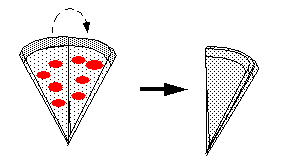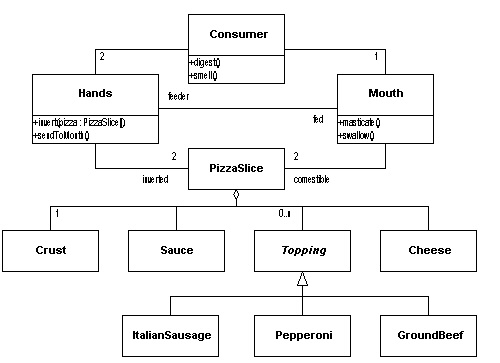Pizza Inversion - a Pattern for Efficient Resource Consumption
by Brad Appleton
<brad@bradapp.net>
http://www.bradapp.net/
last modified 02/12/1999
© 1995-1999 by Brad Appleton. All rights reserved.
Pizza Inversion may sound like a cheesy name for a pattern, but
it describes a recurring solution to a problem that is of fundamental
significance to most software developers I know. I find myself using it
much more frequently than anything in the now famous Design
Patterns book[1]. Keep reading and I'm certain
you'll soon find yourself agreeing with me.
|
Pizza Inversion
|
Object Consumptional
|
Intent
Efficiently internalize the external state of multiple hot pizza
slices, while encapsulating thermodynamic heat-transfer and minimizing
the latency time to access the pizza's surface.
Also Known As
Pizza Sandwich
Motivation
One of the more significant problems faced by software engineers
revolves around the need for nutritional sustenance while maintaining
personal productivity. The impossibly hectic schedules of most software
development projects demands that developers spend more time developing
software than satisfying their hunger. At the same time, developers
need food to remain healthy, alert, and productive. There is even
anecdotal evidence to suggest this factor is sometimes more important
than sleep.
The consumption of pizza (often in a group setting) is a commonly
pursued remedy for addressing this important issue. Pizza often tastes,
and smells, better than more traditional "fast foods," and is very rich
in dairy-content and carbohydrates. Also, it is usually delivered, so
you don't have to wait in line to order your food, or for it to be
prepared and brought to your table.
Because efficiency and scheduling are always important concerns,
developers frequently need to consume multiple slices of round pizza in
a short period of time. The tomato sauce tends to be very hot, however,
and the cheese on top of it adds to the problem by forming an
insulating layer that locks in the heat. To make matters worse, cheese
contains non-negligible levels of fat and, when melting, forms pockets
of grease which can reach exceedingly high temperatures (a condition
aggravated by fatty toppings like ground beef, pepperoni, and Italian
sausage).
When trying to eat pizza quickly, the grease on the cheese and the hot
tomato sauce underneath can severely burn the roof of one's mouth. This
is not only painful, but may also damage the taste buds in this
sensitive region of the mouth, rendering them useless for a short
duration.
The naive approach of waiting for the pizza to cool may at first seem
reasonable. But the resultant increase in the latency-time between when
the pizza arrives and when it has cooled enough for human consumption
imposes an unacceptable performance penalty that impedes programmer
productivity.
Therefore, it is desirable to find a method for eating the pizza quickly
without burning one's mouth. At the same time, one still wants to experience
the full splendor that comes from the taste and smell of a savory pizza
fresh from the oven.
One such method involves inverting one slice of pizza on top of another
slice:

By inverting one of the pizza slices as shown above, the resulting design
structure forms a layered hierarchy in which the crust encapsulates the
cheese, sauce, and toppings from the top and bottom of the mouth. This
insulates the mouth from the hot cheese and sauce while permitting the
pizza to be consumed at approximately twice the usual rate.
Applicability
Use Pizza Inversion when:
-
you have multiple slices of hot, tasty pizza that you wish to consume;
-
you want to eat the pizza quickly and cleanly, without burning the roof
of your mouth; and
-
you are in a very informal social setting.
Structure

Participants
-
PizzaSlice
--
objects of our desire that need to be quickly consumed
-
Crust
--
forms the flat, bread-based layer at the bottom of a PizzaSlice
-
Sauce
--
hot tomato-based liquid that sits atop the Crust
-
Cheese
--
melted mozzarella dairy-product resting above the sauce
-
Toppings
--
food items sprinkled over Cheese or Sauce to add flavor and texture
-
Consumer
--
hungry individual in a hurry
-
Hands
--
dexterous opposable appendages used by Consumer to manipulate PizzaSlices
-
Mouth
--
oral orifice of the consumer into which the pizza must enter before
consumption
Collaborations
-
Crust, Sauce, Cheese, and Toppings are respectively layered in
bottom-up order to form PizzaSlices.
-
Cheese layers of the two PizzaSlices are juxtaposed together with
symmetric orientations.
-
Hands take the Crust of one PizzaSlice and physically invert it by
folding its Cheese-side over the top of the Cheese-side of other
PizzaSlice, until the former is fully inverted, with each slice forming
an approximate mirror-image of the other along the Cheese plane.
-
Hands bring both resulting PizzaSlices simultaneously toward Mouth.
-
Upon entry of PizzaSlices into Mouth, Mouth quickly chews PizzaSlices,
then swallows them.
Consequences
-
Consumed portions of PizzaSlices have Crust on the top and bottom,
forming an effective layer of insulation that encapsulates the hot
Cheese, Sauce, and Toppings from the temperature-sensitive roof of the
Mouth.
-
Through-put is increased by twice the normal rate because PizzaSlices
enter the Mouth two slices at a time instead of one.
-
Cheese, Sauce, and Toppings are each predominantly confined to their
own domains in the resulting layered hierarchy. This "separation of
concerns" forms a Facade[1] which hides internal state
information between the two Crusts, creating an Adaptor[1]
between the Mouth, and the surface of the PizzaSlices
-
Latency time is reduced because Hands do not wait for PizzaSlices to
cool before bringing them toward Mouth to access the PizzaSlice
surface.
-
Pizza with a particularly thick crust, or stuffed pizza (Chicago style,
or otherwise) results in a very tall/deep hierarchy which may prove
unwieldy for consumption.
-
Excessive use of this pattern may cause "object bloat" for the Consumer.
-
Trades off polymorphism in favor of endomorphism.
-
The resultant intake of high levels of cholesterol may result in
blockage of the arteries and cause a health-risk for the Consumer,
necessitating the use of an EmergencyCardiacCare object.
-
The emphasis on efficiency causes the Consumer to miss out on some (but
not all) of the visual and olfactory experience of pizza eating: Rather
than taking in the sight and full aroma of the cheese and the colorful
array of toppings, all you see is crust. The pizza still tastes great,
but it's less thrilling.
Implementation
Consider the following issues when applying the Pizza Inversion pattern:
-
Data Compression and Loss:
One needs to be extra careful when using only a single slice and/or
when the pizza has extra cheese because then excess cheese can easily
ooze out the side and burn your mouth. In this case, use your Hands to
press the pieces (or halves) together to and detach the excess Cheese,
Toppings, and Sauce, before inserting into Mouth.
-
Singleton Slice:
If you have a single slice of pizza you can envision an imaginary line
lengthwise down the center of the slice that divides it into two
symmetrical halves. Fold one half of the slice over (and on top of) the
other half. Another variation that works with a single slice (assuming
you have a round pizza) is to fold the pointed end of the slice towards
the crust end. You don't get full slice coverage this way but some have
expressed a preference for this particular implementation.
-
Olfactory Method:
One of the desirable aspects of eating pizza isn't just the taste, but
also the smell of the steaming hot cheeses, toppings, and fresh-baked
crust. Folding one slice over another slice lessens the effect of this
pleasing olfactory sensation. One commonly employed compromise is to
take a brief moment at the very beginning to fully enjoy the sight and
smell of the pizza before commencing with its consumption. Spend a good
half-minute or so observing and inhaling the full sight and aroma of
the tomatoes, mozzarella, fresh basil, garlic, onion and other spices,
and all of the toppings. Once the visual and olfactory organs have been
used to employ Observer[1] and
Reflection[2] for the non-oral aspects of your
pizza-eating experience, begin folding and then consuming the
PizzaSlices promptly thereafter. This imposes a small but tolerable
performance penalty due to increased latency-time prior to oral
access.
-
Multi-Slicing:
A number of adjacent and attached slices may be folded over onto an
equivalent number of adjacent slices. Hence one could fold two pieces
onto two pieces, three pieces onto three pieces, and so on. For
"individual size" pizzas, simply fold the entire half of the pizza
over onto the other half.
-
Mix-In Slices:
This works particularly well for collaborations involving large numbers
of consuming objects. Rather than trying to satisfy each Consumer's
favorite combination of Toppings, simply order relatively few Toppings
on each pizza and let each Consumer use PizzaSlices from different
pizzas to create their own custom configuration of Toppings.
Known Uses
-
Used frequently at Domino's, Little Ceasar's, Pizza Hut, and Papa John's Pizza
-
Various scenes from the movie "Mystic Pizza"
-
The opening sequence of the movie "Saturday Night Fever"
-
A "calzone" is basically a pre-fabricated instance of Pizza Inversion.
The historical origins influencing this method of pizza consumption may
be traced back to the "Pita" and the Earl of Sandwich.
Related Patterns
-
Adapter[1] is used to create a Facade[1]
that protects the Mouth from the surface of the PizzaSlices
-
Hands play the role of Mediator[1] between the PizzaSlices
and the Mouth.
-
Observer[1] and Reflection[2] participate in
the Olfactory Method implementation of this pattern.
-
Hans Rohnert[3] describes the relationship between
Pizza Inversion, and the Layers[2] and
Whole-Part[2] patterns:
[Pizza Inversion is related to] the Relaxed Layered System variant of
Layers because the respective toppings and especially the cheeses from
the two slices cannot maintain a clear separation between the layers.
Rather, there is direct interaction between different components in
both layers. We even can safely assume that objects will migrate,
mostly from the top to the lower layer.
In a way Pizza Inversion seems related to Whole-Part as well ....
Intuitively speaking two slices layered on top of each other are the
two constituent parts. But Whole-Part explicitly states that direct
access to the parts is not possible.
-
A whole pizza is a Composite[1] of PizzaSlices.
-
Iterator[1] may be used to apply Pizza Inversion for an
entire pizza, or a collection of pizzas.
-
Abstract Factory[1] and Builder[1] are
commonly used by pizza providers to create the pizza, and
Decorator[1] is commonly used to apply the Toppings.
-
A Visitor[1] is frequently employed to deliver the pizza.
-
Not related: Flyweight[1]
Acknowledgements
-
Robert Martin encouraged me to document and disseminate Pizza Inversion
after I described it to him during lunch at Tonelli's in the summer
of 1995.
-
Several subscribers to the patterns-discussion mailing list provided me
with many suggestions for improvement: Eleanor J. Barnes, John Hartley,
Richard Gabriel, Kent Beck, Thomas Gerth, Eric Pearl, Linda Rising,
Jens Coldeway, Hans Wegener, and Hans Rohnert.
-
Participants in the PLoP'97 example writer's workshop for this pattern
made numerous useful comments: Brian Foote, Dirk Riehle, Linda Rising,
Doug Schmidt, and Bobby Woolf.
References
|
[1]
|
E. Gamma, R. Helm, R. Johnson, J. Vlissides.
Design Patterns: Elements of Reusable Object-Oriented Software,
Addison-Wesley, Reading, MA, 1995.
|
|
[2]
|
F. Buschmann, R. Meunier, H. Rohnert, P. Sommerlad, M. Stal.
Pattern-Oriented Software Architecture: A System of Patterns,
John Wiley and Sons, New York, NY, 1996.
|
|
[3]
|
Hans Rohnert. personal correspondence, August 1997.
|


